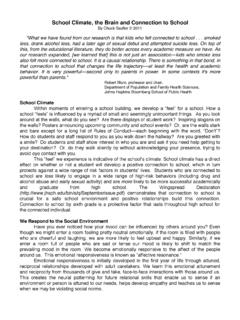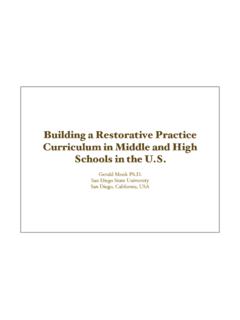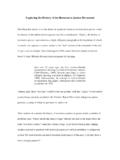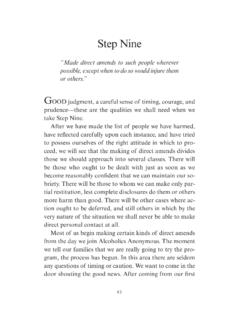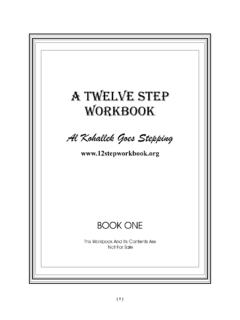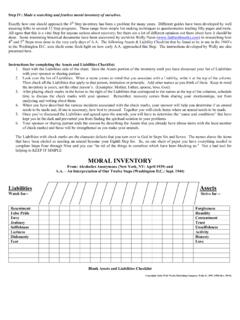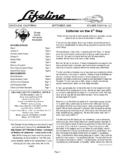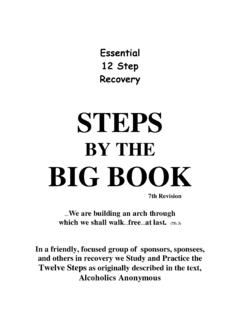Transcription of Restorative Justice and Practices Paper
1 IIRP 2006 Page 1 of 5 Restorative Justice AND Practices Restorative Justice The Basic Tenets of Restorative Justice are around: Harm and Relationships. When contrasting an Adversarial with a Restorative style we find the language differs: Adversarial: What happened? Who s to blame? What punishment is needed? Restorative : What happened? What harm resulted? What needs to be done to make things right? There are several definitions of Restorative Justice worldwide, none universally accepted, though the most widely accepted and used is: Restorative Justice is a process whereby those most directly affected by wrongdoing come together to determine what needs to be done to repair the harm and prevent a reoccurrence.
2 Restorative Justice is a philosophy and ought to guide the way we act in all our dealings Justice means - Justice for all in any circumstance Braithwaite s Hypothesis Effective Restorative Justice and Practices foster awareness of how others have been affected by inappropriate behaviour. This is done by actively engaging participants in a process which separates the deed from the doer allowing participants to make amends for the harm caused. In his book Crime, Shame and Reintegration John Braithwaite tells us (in shorthand): Restorative Justice and Practices allow: The act (unacceptable behaviour) to be rejected because they failed to meet expectations or standards Whilst: Acknowledging the intrinsic worth of the person and their potential contribution to society (the community, school, workplace, etc.)
3 Every instance of wrongdoing or conflict is seen as an opportunity for learning and can be addressed either informally through the conversational use of key questions or more formally through a Restorative conference. Our experience within the organisations that form the International Institute for Restorative Practices (IIRP) over the last three decades and in particular the last decade in respect of Restorative Justice ; led us to realise that a discreet one off Restorative intervention in the form of a Family Group Conference (FGC), Victim and Offender Mediation (VOM) or Restorative Conference (RC) is only one form of Restorative response.
4 In many cases this is all that is needed, whilst in others a more long term and comprehensive Restorative approach is required or at least desirable. IIRP 2006 Page 2 of 5 Restorative Practices The IIRP defines five main strands of Restorative Practices on a continuum as follows: Affective Statements which are brief comments about how others were impacted by the person s behaviour. Affective Questions which are one step further, asking the wrongdoer questions like who was affected, how they were affected, etc. Small Impromptu Conference where you bring together a few people to talk about the incident, its impact and what to do next The Large Group or Circle which allows everyone to have some say in what should happen as a result of the wrongdoing The Formal Conference which involves more planning and preparation and tends to be more structured and complete.
5 The full Restorative Conferencing model sits at the formal end of the informal to formal Restorative Practices Continuum and is largely used in cases where responsibility has been accepted and harm acknowledged. Restorative Conferences have been used for many different purposes over the last decade. Some have been cases involving full acceptance of responsibility and acknowledgement of harm caused, whilst others have not. Some have involved all parties to the incident whilst others have provided a service to one or the other party and their respective supporters. It is not always appropriate or necessary to hold a full conference for all incidents and in fact the use of Restorative Practices at all levels, from informal through to formal is to be recommended.
6 When Restorative Practices and language are imbedded into the way we deal with all conflict and inappropriate behaviour we are most likely to make a difference in the lives of those harmed and affected and the lives of perpetrators too. Restorative Practices as defined by the IIRP have four key elements which make them explicit rather than implicit. These are: 1. Social Discipline Window 2. Fair Process 3. Free expression of Emotions 4. Relational ( Restorative ) Questions 1. Social Discipline Window Restorative Practices are about working WITH people rather than doing things TO or FOR them. It is about offering High levels of Support, whilst challenging inappropriate behaviour through High levels of Control, encouraging acceptance of responsibility and the setting of clear boundaries.
7 IIRP 20065controlcontrol(limit(limit--setting , discipline)setting, discipline)LOWLOWHIGHHIGHHIGHHIGH supportsupport(encouragement, nurture)(encouragement, nurture)Adapted by Paul McCold and Ted Wachtel from Glaser, Adapted by Paul McCold and Ted Wachtel from Glaser, Discipline WindowSocial Discipline WindowTOTOWITHNOTNOTFORFOR restorativeneglectfulneglectfulpunitivep unitivepermissivepermissive IIRP 2006 Page 3 of 5 2. Fair Process Kim & Mauborgne, in their article 'Fair Process: Managing in the Knowledge Economy' for the Harvard Business Review in July August 1997 described Fair Process as having three core elements: 1.
8 Engagement 2. Explanation 3. Expectation Clarity Principle 1 - Engagement: Involving individuals in decisions that affect them by asking for their input and allowing them to refute the merit of one another s ideas. Principle 2 - Explanation: Everyone involved and affected should understand why final decisions are made as they are. Creates powerful feedback loop that enhances learning. Principle 3 - Expectation Clarity: Once decisions are made, new rules are clearly stated, so that everyone understands the new boundaries and consequences of failure. What Fair Process Achieves: Fair process builds trust and commitment which Produces voluntary co-operation, which Drives performance, which Leads individuals to go beyond the call of duty by sharing their knowledge and applying creativity.
9 Fair Process then, is about interacting WITH others and allowing them to tell their stories in a way where they are heard and treated with dignity and respect. 3. Free Expression of Emotions If participants are going to reach a shared understanding and feel the process is fair, then within a safe environment with clear meeting protocols around dignity and respect, they need to be free to express all of their emotions (or affects), including those emotions which are negative. Don Nathanson pioneered work in the Psychology of Affect that helps us better understand why human beings act or respond the way they do. In his book Shame and Pride , Don Nathanson builds on the work of Silvan Tomkins, who developed the Psychology of Affect.
10 According to this theory, there are nine innate affects (or emotions). Most affects are experienced within a range from mild to strong. Two of them are positive: o Interest - Excitement o Enjoyment - Joy One is neutral and operates as a restart mechanism: o Surprise - Startle Six are varying degrees of negative: o Distress - Anguish o Disgust o Dismell (when something is physically or emotionally revolting) o Fear - Terror o Anger - Rage o Shame Humiliation IIRP 2006 Page 4 of 5 Shame is nothing but the interruption of one of the positive affects. Anytime one of those affects is interrupted, we will experience varying degrees of shame humiliation.
